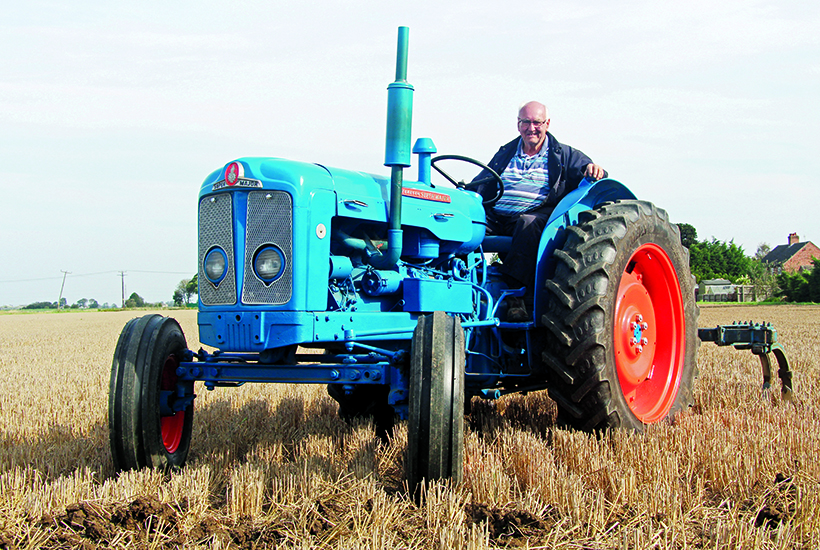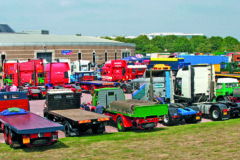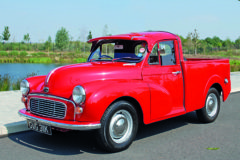Fordson Super Majors and Dextas
Posted by Chris Graham on 6th March 2021
In a south Lincolnshire stubble field, Jonathan Whitlam enjoys the nostalgic spectacle of working Fordson Super Majors and Dextas.

Two versions of the Super Major, working side-by-side in Lincolnshire.
In 1960, the Ford Motor Company launched the new Super Major with much aplomb. It was very much an evolution of the earlier E1A design, but it was one that still truly deserved its new title.
Ford had enjoyed ever-increasing sales with the earlier Power Major incarnation, and this continued once the Super Major appeared. The original Super Major would be replaced in 1963, by the improved New Performance Super Major. This version was short-lived, as Fordson tractor production would be phased out in 1964. Nevertheless, the Super family of Fordson tractors are still remembered as iconic machines of their generation.
When Mick and Jonathan Putterill finished restoring one of their latest acquisitions, it presented the rare opportunity to get the two versions of the Fordson Super Major out in the field, and working side-by-side. So, it was off to South Lincolnshire and, thanks to the generous lending of a stubble field by a neighbouring farmer, we put the tractors through their paces.
Super Major
First up we have Mick on the newly-rejuvenated Super Major, looking resplendent in its new, blue paint with orange wheels and silver front grille. Ford introduced the Super Major in 1960, as the fourth generation of E1A model, which was originally seen in 1951 as the New Major, in turn, introduced to replace the original E27N version of 1945. Using the word ‘Super’ was appropriate, as it was quite an upgrade over the previous Power Major version, with several improvements under the skin.

The Fordson Super Major was first introduced in 1960. Now, 60 years later, this one’s been restored and put back to work in the field.
Externally it looked similar to those that had gone before, with the same tinwork and dimensions. However, new badges were affixed to both sides of the bonnet proclaiming ‘Fordson Super Major’, and the front nose cone badge was amended to read ‘Super Major’ on either side of the wheatsheaf badge. The headlights were now mounted inside the radiator grille itself, instead of projecting from either side, although the external lights remained a feature of many export market Super Major tractors.
Qualitrol control system
The Super Major, launched at the Royal Smithfield Show in 1960, was a great step forward, not least in the rear linkage department, thanks to the fitment of the Qualitrol hydraulic draft control system. It had only been used so far on the Dexta, and now added to the E1A-type for the first time. This system was based on that used on the Ford tractors produced in America, and followed successful trials with a Power Major equipped with such a system.

This is the lever used to control the rear hydraulics on the Super Major, which also included draft control for the first time on an E1A-family tractor.
Another big change was the addition of a differential lock and independent disc brakes, making this a much more versatile tractor than its predecessors. Diesel was the main choice for most British farmers by this time, but a petrol version of the Super Major was offered; a few selling in this country, but most being exported. The engine was the same as that fitted to the Power Major, with around 52hp on offer from its four cylinders.
Bad shape
This tractor was in bad shape when Mick bought it. “The mudguards were rotten, the lift didn’t work, although the tinwork was OK,” he told me. “The engine has never been touched, and it runs beautifully! I have fitted a new cowl, mudguards and had a bit of welding done. New headlamps were fitted, and we fixed the rear lift, as it was all seized up inside.
“We then fitted new tyres and a new handbrake lever, as the original one was bent. It’s a 1963 Super Major, and it’s been in the Peterborough area all its life. It still wears the Peterborough Motors dealer badge who sold it originally, and it has an up-to-date logbook as well. I think it had a front loader on at some time, as you could see where it had been fitted. It doesn’t seem to have done a great deal of work, probably just loader duties for most of its life.”

This is the second Super Major that Mick has owned. He seems pretty pleased to be back in the seat of one!
This is quite a late version of the Super Major, dating from the final year of production, but it’s not Mick’s first such machine. In fact, he had one several years earlier, before selling it for something a bit newer. Now though, he’s once again the proud owner of a Super Major, and it certainly looks the part after all the hard work he’s put into it.
For our working session, Mick had teamed it with a very serious-looking cultivator to rip up the stubble. Working across the tramlines led to a little wheel-slip here and there, and perhaps a finer tuning of the draft control would have helped but, otherwise, the tractor performed very well; the ground being hard and dry at the time.
New Performance Super Major
Next, it was Jonathan’s turn with the New Performance Super Major that’s been in the family’s possession for some time, and still looks lovely despite being an older restoration. On the back was a set of heavy duty Pettitt disc harrows, made just down the road by this Lincolnshire firm that’s sadly no longer with us. These disc harrows are fairly narrow, are fitted with two rows of scalloped discs, and were probably built with export markets in mind. With the dry and hard ground conditions, they did a good job working on the already cultivated stubble, but failed to make much impact on uncultivated land.

The New Performance Super Major was launched towards the end of 1963.
The New Performance version of the Super Major was the last of the E1A family to be introduced; the New Performance range coming along in 1963. Several small improvements were made to make the tractor worthy of its new title but, perhaps the most striking – externally, at least – was the new colour scheme; more grey being used, including on the rear mudguards. Bonnet badges were also dropped in favour of smaller, sticker-type decals, although the front nose cone kept its large, ‘Super Major’ badge and Wheatsheaf logo.
A change of clothes
The colour scheme change began in the US, when the Ford tractor range over there started being painted in the new blue and grey colours from the middle of 1962. At the same time, Dagenham-built tractors also received a similar version of the new colour scheme, when destined for export to America. But the British-market tractors remained in the original livery until the launch of the New Performance range in 1963.
The New Performance version of the Super Major really earned its new moniker thanks to a new, Simms Minimec injector pump, which boosted power to around 53.7hp. Various strengthening was carried out with the transmission and PTO housing to match the increase in engine output, and the gearbox itself was modified to provide a better spread of ratios, including slower speeds in the lower ranges.

Side-by-side, the two Super Major incarnations are very similar and, despite having more power and other improvements, Jonathan still thinks his father’s Super Major has more ‘oomph’ than his later example.
Loader fitted
Jonathan’s 1963 Super Major came from Norwich, was bought in its ‘working clothes’ and fitted with a loader. Mechanically in good condition, it needed painting, and that was all that was required. When new, it came from Mann Egerton at Norwich, but the Putterill’s know nothing more of its history, except that it was used for lifting stock cars around a racetrack. Jonathan doesn’t think it’s done a great deal of work in its life, though.
Which one does he prefer out of the two now in the family’s collection? “I think, power-wise, this and the Super Major are similar; it’s hard to tell any difference,” says Jonathan. “If pushed, though, I’d say that the blue and orange Super seems to have the edge on power, even though the later one is meant to have more.”
Super Dexta
But the two Super Major tractors weren’t the only machines in the Fordson Super class; there was also the Super Dexta and a New Performance Super Dexta. It just so happens that the Putterill’s also own one of each of these, and they also put them to work for me.

The Fordson Super Dexta arrived in 1962, and built on the established success of the Dexta.
Mick took the wheel of the Super Dexta, basically a more powerful version of the little Dexta that was originally launched in 1957, and put it to work with a simple cultivator. It worked already ploughed and cultivated ground with ease.
The three-cylinder Dexta had proved so successful at filling the smaller tractor role that, in 1962, the Super Dexta joined it after being announced towards the end of 1961. It still used the same engine as the Dexta, but this was bored-out to increase the power to 39.5hp; quite a bit more than the Dexta’s 32hp. A new front bonnet cowl was designed for the Super Dexta, which incorporated the words ‘Super Dexta’ at the top, forming part of a rather bulbous bonnet addition. Painted in the same manner as the Dexta and the Super Major, the Fordson line-up could now boast three models of varying size and output.
Mick’s Super Dexta dates from 1963. It belonged to a Holbeach butcher who used it to clean out his cowsheds with a Ferguson front loader. “Unfortunately, they added no anti-freeze and one cold night it cracked the block, but we soon got that fixed”, says Jonathan. “The original paint is still on it and, otherwise, it’s been a superb tractor. It’s very noticeable how much more powerful this little tractor is over our standard Dexta.”
New Performance Super Dexta
Jonathan, meanwhile, was using his late-build New Performance Super Dexta with a spring tine cultivator on the rear. Launched in 1963, the Super Dexta shared the new colour scheme with the larger Super Major and smaller Dexta, and also featured more power, this increasing to 44.5hp thanks to an improved Simms Minimec injector pump. With this sort of horsepower, the little three-cylinder Super Dexta was almost approaching the power rating of the original E1A Major of 1951, and it proved to be a very popular model for Ford.

The New Performance Super Dexta launched in 1963, had more power to spare than its predecessor and was, therefore, even more versatile.
“This is noticeably more powerful than the orange Super Dexta,” says Jonathan. “We bought it locally and did up the engine completely as it was addicted to ‘Easystart’! We also had the injector pump reconditioned, a new paint job and here we go!”
Super legacy
The New Performance Super Major, along with the New Performance Super Dexta and Dexta, were launched all together at the Royal Show in July, 1963. But these models were only intended to see-out the end of tractor production at Dagenham, as the new factory in Basildon was about to come on line. Production of all Fordson models ceased in July 1964, and the brand new 6X range of Ford tractors would leave the Basildon factory by the end of the year. It was the end of an era, the Fordson name being used from 1918, and tractors being built at the factory in Dagenham since 1932.

A spring tine cultivator was used behind the New Performance Super Dexta.
To finish, we got both Super Major tractors working together, side-by-side, making a superb sight as they worked up and down the field, showing off the lines of the last two generations of Fordson E1A-type tractor. As the ultimate evolution of the E1A Major, there’s no doubt that these machines’ smooth-running engines and powerful performance, and their improved specification, earned them the right to be called ‘the Super Class’!

Two models from the three-model New Performance range working together, and looking every bit as good as they would have done back in 1963.
SPECIFICATIONS
Fordson Super Major
| Engine | Ford 3.6 litre |
| Cylinders | 4 |
| Power | 52hp |
| Transmission | 6 x 2 |
| Weight | 2417kg |
Fordson New Performance Super Major
| Engine | Ford 3.6 litre |
| Cylinders | 4 |
| Power | 54hp |
| Transmission | 6 x 2 |
| Weight | 2417kg |
Fordson Super Dexta
| Engine | Ford 2.5 litre |
| Cylinders | 3 |
| Power | 40hp |
| Transmission | 6 x 2 |
| Weight | 1592kg |
Fordson New Performance Super Dexta
| Engine | Ford 2.5 litre |
| Cylinders | 3 |
| Power | 44.5hp |
| Transmission | 6 x 2 |
| Weight | 1592kg |
For a money-saving subscription to Tractor & Farming Heritage magazine, simply click here





